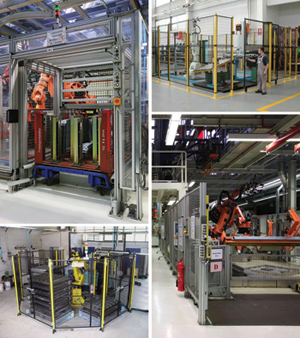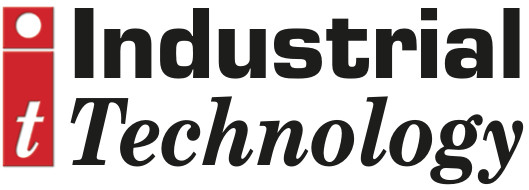
Posted to News on 23rd Apr 2015, 00:00
An engineer's guide to robot cell perimeter guarding
Jeremy Procter, a Member of standards committees ISO/TC 199/WG 6 (Safety distances and ergonomic aspects) and BSI MCE/3 (Safeguarding of machinery), and managing director of Procter Machine Guarding, outlines the requirements for guarding robot cells.

>Industrial robots are increasingly being adopted for automated manufacturing applications beyond the traditional automotive sector where they are now well established. Once programmed, a robot will perform the same task consistently and reliably, but safeguards have to be in place to protect personnel in the vicinity from coming into contact with the robot, end-of-arm tooling or payload. Furthermore, account has to be taken of the unpredictability of personnel and the chance that something might go wrong with the robot, controller, process or materials, resulting in unexpected movements or other hazards.
>Robots offer the advantage that they can be programmed to repeat a particular task with great accuracy, and a further benefit is that they can be reprogrammed to perform a different task, whether that is a variation of the original task or a completely new task elsewhere within the factory. Whenever a robot is reprogrammed, the guarding must be reconsidered to check that it still providing adequate protection. Should the guarding need adjustment, the advantages of modular perimeter guarding systems quickly become apparent.
>Generally modular perimeter guarding systems come in two types: steel and aluminium. In some cases aluminium is preferred for its light weight, clean and 'high tech' aesthetics, and the fact that guarding can be constructed, modified or extended with no need for welding or painting. In other cases, steel is preferred for its rugged construction and 'heavy duty' appearance.
>Since 2014 Procter Machine Guarding has been working in partnership with Bosch Rexroth to specify, design and install the EcoSafe modular aluminium perimeter machine guarding system for customers throughout the UK. EcoSafe frame heights can be specified from 250-2000mm and the extruded aluminium posts are either 45x45mm or 45x90mm. Panel frames are assembled from 30x30mm aluminium extrusions, with the most common infill being galvanised steel 12AWG (2mm) triple crimp wire, though the specially designed slots in the extrusion can alternatively accept panels up to 5.8mm or 7.6mm thick (depending on the type selected), or 2-4mm or 4-5mm if the optional spring clamps are used. Horizontal or vertical rails can be added to the panels for increased strength and stiffness.
>The Bosch Rexroth EcoSafe range includes a wide choice of standard components and accessories for creating hinged or sliding doors, attaching interlocks or installing glazing panels, for example. There are also specially designed brackets that enable frames to be installed very quickly within the support posts and, importantly, removed rapidly when access is required for maintenance.
>For robot guarding projects requiring steel posts and panels, Procter Machine Guarding usually recommends Satech Strong, a heavier-duty modular perimeter guarding system. However, for projects where small, lightweight robots are used, the Satech Basic modular perimeter guarding is very cost-effective.
>Satech Strong features uprights manufactured from 60x60x2mm rolled hollow section steel, together with panels in which the frame is fabricated from either 20x20mm or 30x30mm steel with 3mm welded wire mesh infill on a 22x100mm grid. Patented fast assembly clamps enable the guards to be assembled quickly and easily - and disassembled again if access is required for maintenance. Whereas the Basic series uses separate posts and base plates, the Strong series benefits from steel bases that are welded to the post for additional strength, and pre-punched with four mounting holes for fixing to the floor. Posts are offered in five nominal heights from 1120mm to 2640mm, and panels in four heights from 960 to 1900mm and seven widths from 200mm to 1500mm.
>Satech Basic uses uprights manufactured from 40x40x2mm rolled hollow section steel, together with panels in which the frame is fabricated from 20x20mm steel with 3mm welded wire mesh infill on a 22x100mm grid. The posts are supported on base plates formed from steel plate with three or four pre-punched holes for securing the guarding to the floor. Posts are offered in five nominal heights from 1120mm to 2640mm and are height-adjustable to accommodate for uneven floors. Panels are available in four heights from 960 to 1900mm and seven widths from 200mm to 1500mm. Customers can choose either screwed assembly or the Satech patented fast assembly clamps.
>A further option is panels with clear polycarbonate or sheet steel infills, the latter of which can be equipped with viewing windows if required. There is an extensive choice of Satech access gates, ranging from single- and double-leaf hinged gates, tracked or cantilevered sliding gates, and rise-and-fall gates.
>Any perimeter guards should comply with EC and HSE requirements and be CE marked or issued with a Declaration of Conformity as appropriate on completion. Standards to be complied with include the following:
>BS EN ISO 12100:2010 Safety of machinery. General principles for design. Risk assessment and risk reduction
>BS EN 953:1997+A1:2009 Safety of machinery. Guards. General requirements for the design and construction of fixed and movable guards
>Note that BS EN 953 will shortly be superseded by BS EN ISO 14120 Safety of machinery. Guards. General requirements for the design, construction and selection of fixed and movable guards
>BS EN ISO 13855:2010 Safety of machinery. Positioning of safeguards with respect to the approach speeds of parts of the human body
>BS EN ISO 13857:2008 Safety of machinery. Safety distances to prevent hazard zones being reached by upper and lower limbs
>BS EN 349:1993+A1:2008 Safety of machinery. Minimum gaps to avoid crushing of parts of the human body
>BS EN ISO 10218-2:2011 Robots and robotic devices. Safety requirements for industrial robots. Robot systems and integration
>BS EN ISO 11161:2007+A1:2010 Safety of machinery. Integrated manufacturing systems. Basic requirements
>Although HSG43 Industrial Robot Safety is no longer published by the HSE (Health and Safety Executive), this publication contains valuable guidance.






